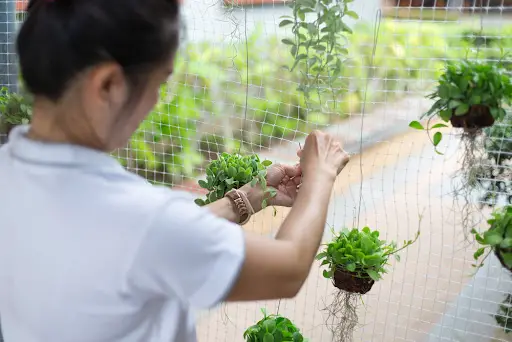Are you thinking about creating a vertical vegetable garden to save space, time, and stress? If so, you must know the best way to grow vegetables in a vertical garden, and we have that information right here for you.
In this article, we take a deep dive into the best ways to prepare, maintain, and utilize a vertical garden in any space to ensure the best vegetable growth possible.
Benefits Of Growing a Vertical Vegetable Garden
There are many benefits associated with growing a vertical vegetable garden, making these unique designs and ideas seem ideal.
If you are on the fence about whether or not vertical gardening is right for you, here are a few benefits to consider.
Saves Space
Vertical vegetable gardening saves you a ton of space, whether in your backyard or on your home patio. Vertical gardens utilize unused vertical space, allowing you to do more with the small space you do have.
These gardens are great for all homes, schools, or businesses, but are extremely beneficial to any location with a small amount of extra space.
Reduces Water Use
Many vertical gardens have one garden space stacked above another. This is a great way to limit the amount of water you use because overflow from the top garden will trickle down to the lower layers.
Gives Options for More Locations
Vertical vegetable gardening can allow you to place a garden in a location you otherwise wouldn’t be able to utilize, which can be helpful when saving space, looking for proper sunlight, or creating a beautiful design in an otherwise unused area.

Try These 5 Steps for Growing a Vertical Vegetable Garden
Growing a vertical vegetable garden is easy as long as you preplan and ensure you have the proper materials and products.
If you are ready to create your vertical garden, here is a quick guide to accomplishing it in five easy steps.
1. Locate a Great Space
Before you set up your garden, take time to go out and observe your space. You want to ensure that your vertical garden has plenty of access to natural sunlight. It should be in an area of your lawn where it won’t get in the way. People won’t walk into it or knock it over, and it should not be exposed to harsh weather conditions.
Another thing you want to think about is who has access to your vegetables. If your vegetable garden is outdoors, will it provide easy meals for critters, birds, or pets?
Planning your vegetable garden will give you time to account for all the obstacles you may face once you plant it, and there is no going back.
2. Choose a Vertical Vegetable Garden Structure
Once you locate the ideal space for your vertical garden, it is time to choose the best structure for the type of garden you are looking to create.
If you are going to be growing vegetables that require the same soil, nutrients, and space, you can consider a single vertical system that doesn’t separate the plants from one another. If you grow vegetables that don’t tend to play well together, then a vertical garden option is best for you.
A few fun and easy vertical garden options include:
- A vertical standing pallet
- Separate pots and planters
- Stacked terracotta planters
- Plastic pop bottles
- Raised planter beds
- Plastic gutters
3. Choose the Vegetables You Want to Grow
What types of plants are you thinking about growing? Are you going to want them to start as seeds, or do you plan on using already sprouted vegetable plants?
An important thing to keep in mind when choosing which plants to place into your vertical vegetable garden is deciding which ones are ideal for the time of year, climate, and resources you have.
If you plan on planting your vegetables from seeds, you should consider purchasing a soil specifically designed for that.
Vegetables that are suitable for vertical planters include but are not limited to:
- Pole beans: Pole beans are a great option for those who want a ton of produce from one plant. These vegetables grow plentiful without taking up very much space.
- Tomatoes: While many people see tomatoes as large bushy plants, they can be trimmed down and pruned to grow upright on a single stem, not requiring much growing space.
- Peas: Peas already naturally grow vertically and do very well in an upright garden, especially when provided with a sturdy, easy-to-locate trellis.
- Melons: Melons require adequate space for their vines to move about the garden space. However, smaller melons do very well in slanted vertical gardens. While these may not be vegetables, they are delicious and worth noting.
4. Use the Best Soil and Nutrients
Before planting your vegetables in your vertical garden, make sure you have all of the best products and food for growing healthy produce.
Because vertical gardens will lack natural resources often found in the ground underneath the surface of your yard, you want to purchase quality soil and fertilizer to provide your vegetables with plenty of nutrients.
Most vegetables can use the same type of soil, but it is important to double-check the products you buy to ensure you give your garden all the materials it needs.
A great way to ensure your plants are getting the best food possible is to create a compost pile. This will provide you with ample amounts of natural resources to feed your vegetables.
5. Maintain Your Garden Properly
Once your vertical structure is complete and has the best setup possible for growing ideal vegetables, you have to make sure the structure you put together provides easy access to maintain your crops frequently.
Growing veggies in a container restricts their access to natural resources and their ability to grow freely, so you want to keep a close eye on the soil and plant growth.
Be sure that you can easily get to your garden to provide maintenance it needs such as water, fertilizer, and having room to harvest once your plants are ready for consumption.

Tips for Creating a Successful Vertical Vegetable Garden
There are a handful of important factors for a successful vegetable garden, whether it is a vertical one or a traditional one planted in the ground. Keeping these details in mind will ensure your vegetables will have access to essential care and conditions to produce delicious vegetables in no time.
Here is a list of tips to consider when growing your vertical vegetable garden.
Pick Smaller Vegetable Plants for Smaller Gardens or Containers
If you have limited space and a smaller type of vertical garden, such as small planter pots or a vertical leaning pallet, consider planting vegetables that don’t require deep soil, such as lettuce, herbs, bush bean, and other leafy options.
Keep Your Soil Damp
Vertical gardens require watering more frequently than other gardens. When debating whether your vegetables need more water, check the soil. The soil in a vertical garden should be moist but not soaked. If the soil feels dry to you, then you know it’s time to get the watering can.
Remember to Reduce the Risk of Too Much Shade
While we explained the importance of proper sunlight, keep in mind that the location of your garden isn’t the only thing that can reduce sun exposure to your crops.
Some vertical garden designs overlap, causing the top planter to block the sunlight for the plants that are underneath. Keep this in mind when looking for a way to set up your vegetable garden.
Keep the Weight of Your Plants in Mind
When creating a vertical garden structure, remember to keep the weight of the plants, soil, and water in mind. Make sure that your garden can hold the weight of all your plants and planters that you are going to set on the structure.
This detail is especially true for gardens utilizing hanging planters and pots.
Summing Things Up
Vertical vegetable gardens are unique and interesting, providing people in all different living spaces a chance to access freshly grown vegetables at their fingertips. As long as you take your time and do a little homework, setting up and maintaining a vertical vegetable garden can be a piece of cake.





